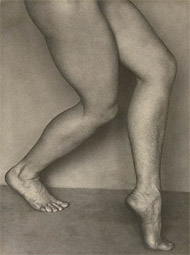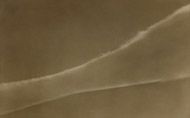|
Edward Weston is among America's most revered photographers. His long career, which began in Los Angeles, spanned nearly four decades that witnessed the start and finish of two world wars and the Great Depression, the rise of photography as the dominant medium for commercial advertising, and the emergence of the United States as a major cultural center. Amid these developments, Weston forged a path that was both conservative and progressive. He was a proponent of tripod-mounted cameras and large-format negatives, rigorously considered compositions, and impeccably wrought contact prints in the service of Modernism. A craftsman with a camera, Weston wed a straight, unmanipulated photographic aesthetic with vernacular subjects, pursuing Modern art as a personal way of seeing the world.
This exhibition traces the breadth of Weston's accomplishments in California, Mexico, and across the United States, displaying prints drawn primarily from the Getty Museum's holdings.
|
 |
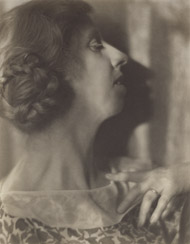
 |
 |
Imogen Cunningham, 1922
© 1981 Arizona Board of Regents, Center for Creative Photography
|
 |
 |
Friends and colleagues inspired Weston throughout his life. Particularly during his early career in Los Angeles, Weston's intellectual and artistic circles—which included a community of California artists and writers—provided an environment in which his creative energies could thrive.
Weston and Imogen Cunningham met in 1920 and became friends, admiring one another's skill, trading prints, and discussing photography. Cunningham had created a large body of Pictorialist and Symbolist works during the teens and was, like Weston, moving toward new modes of expression in the 1920s. Here Weston captured her in a dappled light typical of her own early prints, creating a portrait that pays dual homage to the photographer and her work.
|
 |
|
In 1923, Weston changed his life dramatically. He left his wife, three youngest sons, and the Los Angeles artistic milieu in which he had gained prominence to sail for Mexico with his oldest son, Chandler, and his model, student, and lover Tina Modotti. Modern art flourished in Mexico in the 1920s where it was informed by European avant-garde trends and infused with native traditions and socialist ideals. There Modotti facilitated Weston's introduction to artists such as the muralist Diego Rivera, who greeted his work enthusiastically.
The two and a half years Weston spent in Mexico was a period of immense stylistic exploration and maturation for him. He expanded the range of his work, adding clouds, still lifes, and landscape to his repertoire of portraits and nudes. He also honed his visual approach there, creating images characterized by a new emphasis on simplified, volumetric form.
|
 |
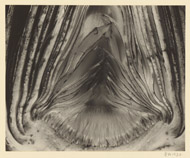
 |
 |
Artichoke, 1930
© 1981 Arizona Board of Regents, Center for Creative Photography
|
 |
 |
Weston returned to California from Mexico in November 1926. In 1928 he moved to Carmel, a small town along the central California coast with a significant population of artists. There he opened a portrait studio with his son Brett, who had become a photographer himself. In his free time Weston explored the forms of peppers and other vegetables, which he typically ate after photographing them.
Weston's work from the late 1920s to the early 1930s is remarkably coherent, despite the diversity of subject matter. In these compositions, the forms of shells, nudes, vegetables, and rocks come to resemble one another, revealing Weston's interest in universal life rhythms and his concept that "all basic forms are so closely related as to be visually equivalent."
|
 |
 |
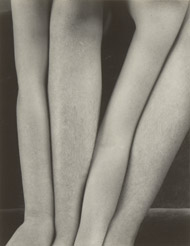
 |
 |
Nude, Charis Wilson, 1934
© 1981 Arizona Board of Regents, Center for Creative Photography
|
 |
 |
|
In 1934 Weston met Charis Wilson, the well-educated, 20-year-old daughter of a prominent Carmel family. She began as a model for Weston's nude studies, but the two were soon romantically involved. Wilson remained with Weston for nearly 12 years, and they were married from 1939 until 1945. Not long after they met, the couple moved to Santa Monica. The Depression years had been difficult, and Weston may have believed that his chances for making money would be better in the Los Angeles area than in Carmel, which depended heavily on the tourist trade.
Many of Weston's nudes from the mid-1930s are close-up depictions of body parts made using his smaller camera, which held negatives four by five inches in size. Set against a deep black ground, Charis Wilson's arms and shins are tightly framed in this image, slightly off center, and removed from the context of her body.
|
 |
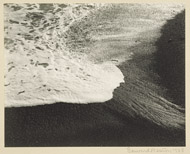
 |
 |
Point Lobos, November 1938
© 1981 Arizona Board of Regents, Center for Creative Photography
|
 |
 |
In 1937 Weston became the first photographer to receive the prestigious Guggenheim Fellowship. For a year, he traveled around the western United States with Charis Wilson, creating large-scale landscapes, a subject he had not pursued in depth since his time in Mexico. The grant was renewed in 1938, part of which Weston spent at his new residence in Carmel, developing and printing negatives made in the preceding months.
Weston created some 1,400 negatives during this remarkably productive time, and his visual approach became increasingly expansive. His deliberate, methodical technique of the late 1920s and early 1930s, when he spent hours creating single still life arrangements in his studio, gave way to greater spontaneity and an embrace of diverse views. His frame now encompassed hills, valleys, and coastlines, not just the rocks and tree stumps found there. He directed his attention to less static subjects, incorporating moving elements such as breaking waves or drifting clouds.
|
 |
 |
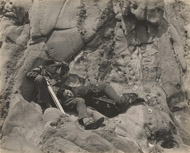
 |
 |
Furlough (The Newhalls), early June 1945
© 1981 Arizona Board of Regents, Center for Creative Photography
|
 |
The constraints imposed by World War II, including the closure of Point Lobos to civilians and gas rationing, kept Weston close to his home in Carmel during the 1940s. He developed a series of environmental portraits of family and friends and began staging elaborate tableaux. Here, he photographed his friends the curators Beaumont and Nancy Newhall against a rocky outcropping. Beaumont, who had been drafted, was on furlough when the photograph was made. This picture's calmly emotive qualities, which contrast with the bold intensity of Weston's portraits from the 1930s, are in keeping with his landscape work of the period.
In 1948 Weston laid down his camera due to Parkinson's disease. He focused on organizing his achievements during the last decade of his life, publishing a book on his intimate views made at Point Lobos, attempting to publish a book of his nudes, and preparing several sets of more than 800 of his favorite photographs.
|
 |
